Noticed by Aragon and Dali
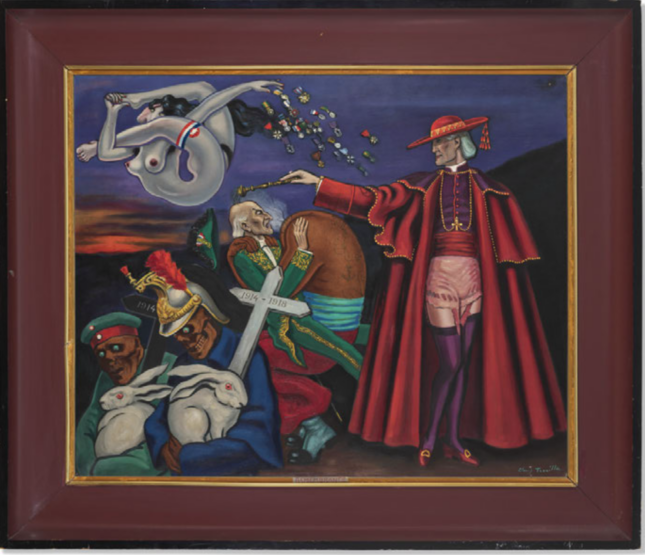
Imagine an artist who was noticed from 1930 by the poet Louis Aragon and the painter Salvador Dali. He would later join the surrealist group of André Breton. Imagine a painter whose body of work would be entirely made up of 120 pictures (according to him) and who would hate to part with his artworks. He answered to the amusing name of Clovis Trouille (1889-1975) (Trouille in colloquial French means fear) and he is the subject of a sale in Paris on 3 October at Christie’s.
Leaving a fortune
It contains no less than 88 lots, the entirety of his studio, which was left after his death to his daughter Alice Trouille. For a long time his children kept hold of the ensemble. According to the grandson, Henri Lambert, who I met, the father said to his daughter, “I am leaving you a fortune”. The ensemble today has an estimate of 3.2 million euros.
For insiders
He has been the subject of a few exhibitions in museums, such as in 2002 at the Museum of Modern Art in Ostend, Belgium, or in 2007 at the Musée de Picardie in Amiens. But a dispute among Alice Trouille’s heirs has resulted in these historic auctions which, it seems, are making many surrealism fans salivate all over the world.
Daniel Filipacchi
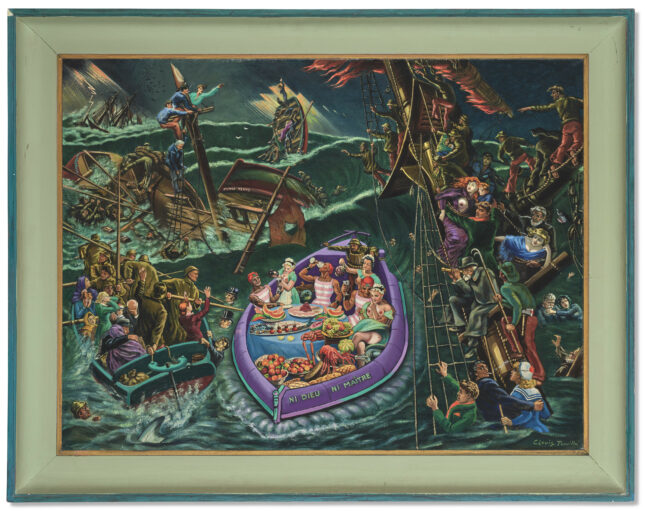
Clovis Trouille
Trouille is more of a surrealist for the initiated. One of his most important collectors is a French media figure, Daniel Filipacchi, who now lives in retirement in the United States. He talks about his passion for his paintings in his autobiography (1): “This Clovis Trouille that is the apple of my eye, “Cérémonial des magiciennes”, is in fact the only object I had the urge to take with me when our building on the Champs-Elysées totally burned down”.
Trouille is on display until 13 January with a painting, “Le rêve d’Alice”, from 1945 – it belongs to the Trouille heirs – as part of the major surrealist exhibition that’s currently taking place at the Centre Pompidou (See here the report about the show).
Makeup artist
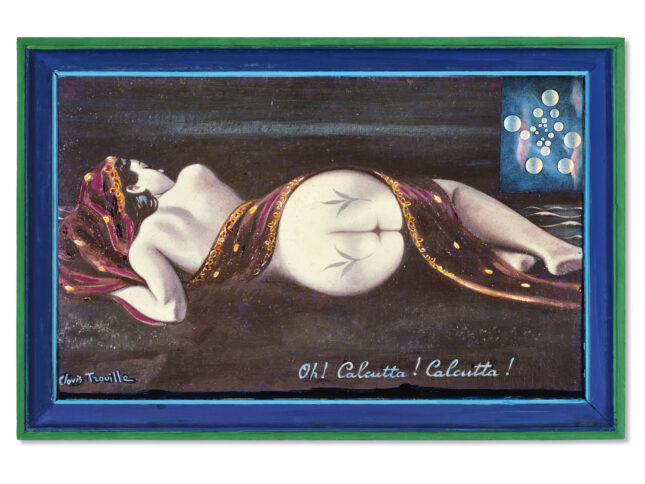
As his grandson explains, this figure is not a typical artist. “During the week he was a makeup artist at a manufacturer for haute-couture mannequins in Paris at Pierre Imans. Sunday was a blessed day, when he would paint. His studio was at his house near the Buttes-Chaumont. It was here that I discovered sex and also death, in his paintings.” Filipacchi also describes him: “with his appearance of a CEO, wearing a tie, looking serious, he lived in a large house in Paris in the company of a charming old lady, his girlfriend. The walls were covered with his paintings, which he didn’t want to part with under any circumstances.”
Subversion
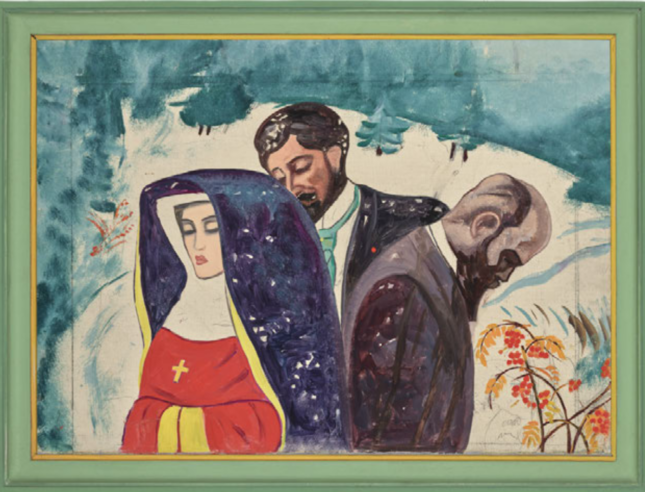
In the monograph on him (2) art historian Bernard Marcadé adds: “Clovis Trouille did not particularly seek the blessing of critics,” and cites the artist on the subject of his lack of desire for recognition or any kind of commercial success: “A painting made with a view to sell it is already a failure.” Trouille is a free spirit who is part of the great history of subversion in paintings. This is why he seduced the surrealists.
Super-realist
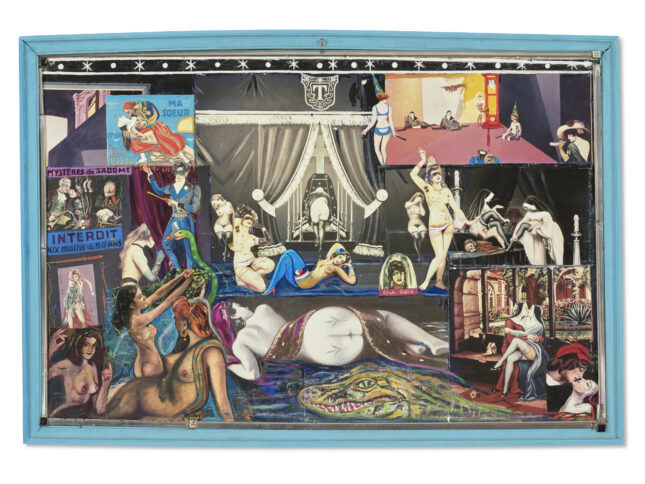
But even though he exhibited in 1946 at the Maeght gallery in Paris on the invitation of André Breton, he preferred to describe his painting as “super-realist”. He spoke of an art that was “voyou, voyant voyeur” (“rogue, seer, voyeur”). Because in fact the painting of the Parisian trained at the Ecole des Beaux-Arts in Amiens, often inspired by photography, is anti-clerical, anti-army – he was traumatized by the First World War – and is often sexual in nature. To the extent that when the Raymond Cordier gallery staged his first personal exhibition in 1963 – during which nothing was sold, according to Henri Lambert – it was only accessible on invitation, in order to defy censorship.
To appreciate is to support.
To support is to donate.
Support JB Reports by becoming a sustaining Patron with a recurring or a spontaneous donation.
No market
According to specialists there is not really a market yet for Clovis Trouille quite simply because ordinarily his works that are in circulation are rare. The last big event for his market dates from 1993 when the Parisian gallery 1900-2000 dedicated an exhibition to him and a catalogue.
Italian Nun smoking
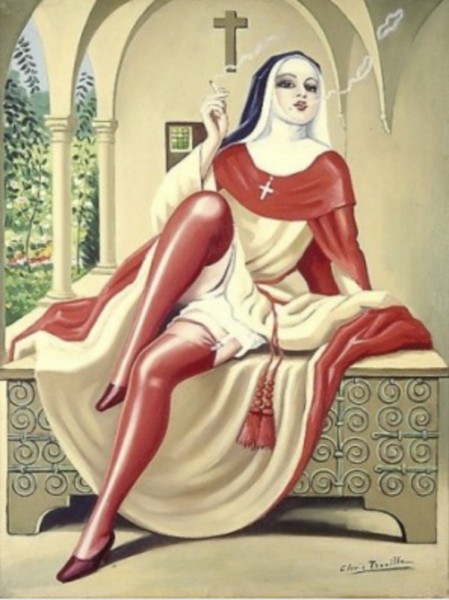
At the sale on 3 October the works have an estimate of between 2000 euros – for the works from his early days – and 100,000 euros. At auction the record price for the artist dates from the sale of André Breton’s studio in 2003. A “Religieuse italienne fumant la cigarette” (Italian Nun Smoking a Cigarette) revealing her alluring underwear, painted in 1944, was auctioned at the time for 240,000 euros. Anecdotally, Trouille nurtured an obsession with nuns following a failed love story with a young lady who had taken the veil.
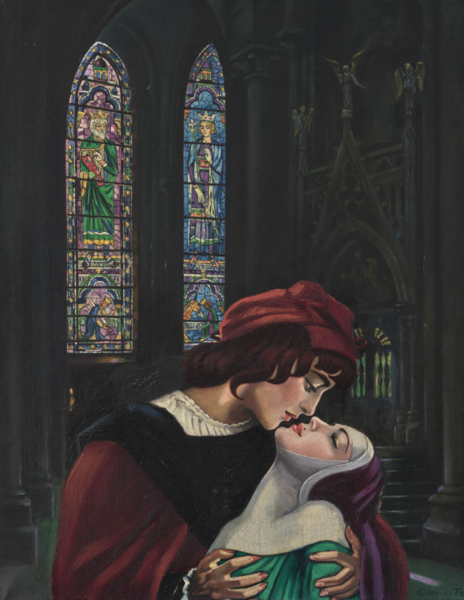
The expert at the Christie’s sale, Valérie Didier, adds “we know that in the context of a private sale a painting was sold for over half a million euros.” The most recent transaction was obtained in June 2024 in Paris with “Le refoulement des mauvais désirs”, a canvas sold for 88,400 euros. It depicts two men with their heads lowered in a snowy landscape. A nun with her eyes closed has her back to them. A subsequent version of the same subject is presented at Christie’s with an estimate of 20,000 euros.
Anti-everything painting
It also contains the historic “Remembrance” canvas that the artist himself described as an “anti-everything painting”, which got him noticed by Dali and Aragon. We see a shower of medals hurled by a supple goddess with shapely curves over priests, while dead soldiers are fleeing below (estimate 70,000 euros). One of the paintings with the richest composition is “Le bateau ivre”, the description of a revolt on a boat accompanied by the phrase “Ni dieu ni maitre” (Not god nor master).
Pop before Pop
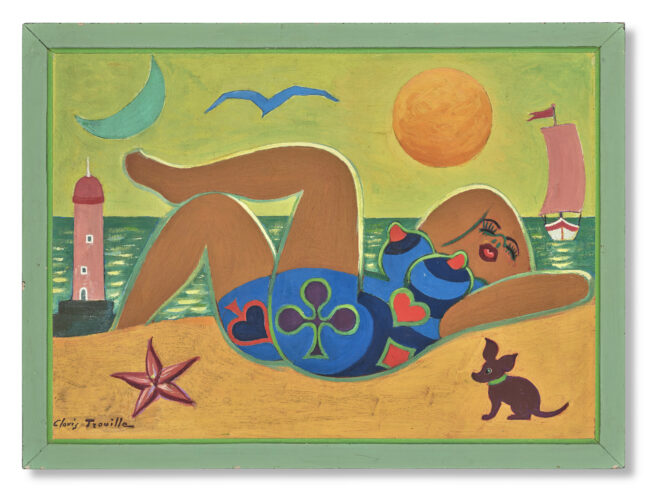
Filipacchi says that Trouille borrowed a painting three times that he had sold in order to do retouches. The work in his eyes was never finished. We can see in the sale the expression of his perfectionism by the fact that the majority of the canvases also had been framed by him. Occasionally the artist’s vein heralded a kind of Pop Art, this is the case for example in “Les seins flotteurs”, which shows in 1957 a large woman on the beach depicted in candy colours (estimate: 20,000 euros). In the style of Marcel Duchamp his titles play a major role in the understanding of the artwork. In “Oh Calcutta! Oh Calcutta” from 1946, which he inscribed at the bottom of the canvas, he plays with the words unveiling at the centre of the composition the buttocks of an Eastern woman (estimate: 10,000 euros).
When we express concern to the expert at Christie’s about this mass of paintings that will be offered up to the market, she answers back: “The context of the centenary of surrealism is ideal.” Clovis Trouille didn’t like the art market. The latter should, however, give him his credit.
(1) Daniel Filipacchi. Ceci n’est pas une autobiographie. Bernard Fixot. 2012
(2) Clovis Trouille; Actes Sud 1999.
Support independent news on art.
Your contribution : Make a monthly commitment to support JB Reports or a one off contribution as and when you feel like it. Choose the option that suits you best.
Need to cancel a recurring donation? Please go here.
The donation is considered to be a subscription for a fee set by the donor and for a duration also set by the donor.




